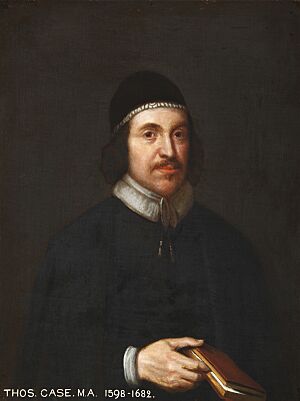Thomas Case facts for kids
Thomas Case (born 1598 – died May 30, 1682) was an important English church leader. He was a Presbyterian, which was a type of Protestant Christian belief. He was also a member of the Westminster Assembly, a group of religious leaders who met to discuss and reform the Church of England. Thomas Case strongly believed that the government should follow Christian principles.
At first, he supported the Parliamentary side during the English Civil War. This was the group that fought against King Charles I. However, he later disagreed with those who executed the king (the regicides). After that, he supported the return of the king, known as the Restoration of the Stuart monarchy.
Contents
The Life of Thomas Case
Thomas Case was born in Kent, England. His father, George Case, was a vicar, which is a type of church minister. Thomas went to school in Canterbury and then at Merchant Taylors' School, Northwood.
Early Education and Ministry
In 1616, he became a student at Christ Church, Oxford University. He earned his Master of Arts degree in 1623. After university, he worked as a curate in North Repps, Norfolk. A curate is a minister who helps the main priest. Later, he became the main minister in Erpingham.
In 1635, he became a preacher in Manchester and Salford. However, he faced problems because he did not follow all the traditional church rules.
Family and Influence
In 1637, Thomas Case married Anne Mosley. Her family was very important and connected him to influential people. Through his marriage, he became connected to Salford chapel and to another important minister, John Angier.
His stepson, Sir Robert Booth, later became a very important judge in Ireland. Thomas Case helped educate him and taught him his own Presbyterian beliefs.
Work in London and the Westminster Assembly
From 1641 to 1642, Thomas Case gave lectures in several churches in London. In 1643, he became a member of the Westminster Assembly. This was a major group that worked to reshape the Church of England. In 1645-1646, he was appointed as the rector (main minister) of Stockport, Cheshire.
Challenges and Imprisonment
In 1649, Parliament removed him from his church job at St. Mary Magdalen, Milk Street. This happened because he refused to sign an "Engagement". This "Engagement" was a promise to be loyal to the new government after the king was executed. After this, he continued to give lectures in other London churches.
On May 2, 1651, Thomas Case was arrested. He was one of several ministers put in prison. They were suspected of being part of a plan to bring King Charles II back to England. He spent about six months in the Tower of London. After his release, he became the rector of St. Giles-in-the-Fields, London, around 1652.
The Restoration and Later Life
In 1660, when King Charles II returned to England (the Restoration), Thomas Case was chosen by other Presbyterians to congratulate the king. He even became a chaplain to the king, which is a minister who serves royalty.
In 1661, he took part in the Savoy conference. This was a meeting to try and find common ground between different church groups. However, in 1662, he was removed from his church position again. This was because of the Act of Uniformity 1662, which required ministers to follow strict rules of the Church of England. Thomas Case could not agree to these rules.
When he passed away in 1682, Thomas Case was the last surviving member of the Westminster Assembly who had disagreed with the official church rules.
Writings of Thomas Case
Thomas Case wrote several books during his lifetime. These books shared his religious thoughts and teachings.
- Correction, Instruction: or, A Treatise of Afflictions (published in 1653)
- Imitation of the Saints opened in Practical Meditations (published in 1666)
- Mount Pisgah: or, A Prospect of Heaven (published in 1670)


